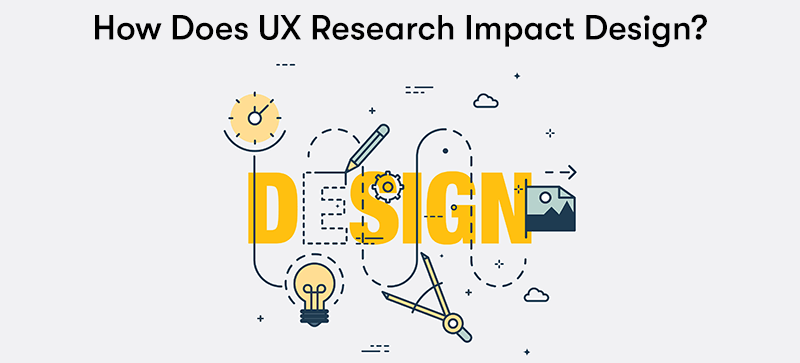How to Conduct UX Research
In the fast-paced world of digital design, understanding your users is paramount to success. UX (User Experience) research guides you toward creating products that not only meet but exceed user expectations.
In this blog, we will delve into the essential methods, strategies, and how to harness the full potential of UX research. We will equip you with the knowledge and tools to elevate your products or services user experience. Let's embark on a journey that transforms user-centred design from theory to practice.
What is UX Research?

UX research is a critical component of the design and development process for digital products, websites, applications, and services. It involves systematically investigating and understanding how users interact with a product or system to assess and improve its usability, functionality, and overall user satisfaction. The primary goal of UX research is to create products that meet the needs and preferences of users, ultimately leading to a positive and enjoyable user experience.
UX research is a multidisciplinary field that combines psychology, design, and technology to create user-friendly and compelling digital experiences. It helps organisations make informed design decisions, reduce user frustration, and ultimately deliver products and services that users find valuable and enjoyable to use.
How To Conduct UX Research

UX research involves a systematic approach to understanding user behaviours, needs, and preferences to inform the design and development of digital products and services. Here's a step-by-step guide on how to conduct UX research:
1. Define Your Objectives
Start by clearly defining your research goals and objectives. What specific questions do you want to answer? What aspects of the user experience are you trying to improve or understand?
2. Identify Your Target Audience
Determine who your target users are. Create user personas or profiles that represent different segments of your user base. This helps you tailor your research efforts to specific user groups.
3. Choose Research Methods
Select the appropriate research methods based on your objectives and the stage of your project. Standard UX research methods include:
- Surveys: Distribute questionnaires to collect quantitative data on user preferences and behaviours.
- Interviews: Conduct one-on-one or group interviews to gather qualitative insights and in-depth feedback from users.
- Observations: Observe users interacting with your product in real-world scenarios to understand their natural behaviours.
- Usability Testing: Have users perform tasks with your product while recording their interactions and gathering feedback.
- Card Sorting: Use this method to understand how users organise and categorise information or content.
- Analytics Analysis: Analyse data from tools like Google Analytics to gain insights into user behaviour on your website or app.
4. Recruit Participants
Identify and recruit participants who represent your target audience. Ensure your participant pool is diverse and includes a range of user types, demographics, and expertise levels.
5. Prepare Research Materials
Create research scripts, questionnaires, interview guides, or usability testing scenarios. Ensure that these materials are clear and unbiased to minimise potential researcher bias.
6. Conduct the Research
Depending on your chosen methods, conduct the research sessions. If you're conducting interviews or usability tests, be sure to establish a comfortable environment for participants and follow your prepared scripts.
7. Gather and Analyse Data
Collect data during the research sessions. Use thematic analysis to identify recurring themes and insights for qualitative data (e.g., interview transcripts or observation notes). Use statistical analysis tools for quantitative data (e.g., survey responses).
8. Create Research Reports
Summarise your findings in clear, concise research reports or presentations. Include actionable insights, user quotes, and visual representations of data where relevant.
9. Share Findings with Stakeholders
Present your research findings to stakeholders such as designers, developers, and product managers. Use your insights to inform design decisions and prioritise improvements.
10. Iterate and Improve
Use the research findings to make informed design changes and enhancements to your product. Continue to iterate and improve based on user feedback.
11. Monitor and Collect Ongoing Feedback
UX research is an ongoing process. Continuously monitor user feedback, track key performance indicators (KPIs), and adapt your product as needed to maintain a positive user experience.
12. Repeat the Process
As your product evolves, repeat the UX research process periodically to ensure that it continues to meet user needs and stays competitive in the market.
Remember that UX research is not a one-time activity but an integral part of the product development lifecycle. You can create and maintain products that provide exceptional user experiences by consistently conducting research and incorporating user feedback.
Common Methods of UX Research

There are several standard methods of user experience research that UX professionals use to gather insights into user behaviour, preferences, and needs. These methods can be broadly categorised into qualitative and quantitative research approaches. Here are some standard UX research methods:
Qualitative UX Research Methods
| User Interviews | Conduct one-on-one or group interviews with users to gain a deep understanding of their experiences, pain points, and motivations. |
| Usability Testing | Have participants perform specific tasks with your product while you observe their interactions and collect feedback. This method helps identify usability issues and areas for improvement. |
| Contextual Inquiry/Observation | Observe users in their natural environment as they interact with your product or perform relevant tasks. This provides insights into real-world usage patterns. |
| Card Sorting | Ask participants to organise and categorise content or features to understand how users mentally structure information and navigate your product. |
| Diary Studies | Have users keep journals or diaries to record their interactions and experiences with your product over an extended period. This method provides longitudinal insights. |
| Think-Aloud Testing | During usability testing, ask participants to verbalise their thoughts and actions as they interact with your product. This helps uncover thought processes and challenges. |
| Ethnographic Research | Immersing researchers in the users' environment to better understand their daily lives and how your product fits into their routines. |
| User Surveys | Create surveys to collect quantitative data on user preferences, behaviours, and demographics. Surveys are useful for gathering a large amount of data from a broad user base. |
Quantitative UX Research Methods
| Website/App Analytics | Use tools like Google Analytics to collect data on user behaviour, such as page views, click-through rates, bounce rates, and conversion rates. |
| A/B Testing | Conduct experiments by offering two or more variations of a design or feature to different user groups and measure which one performs better in specific metrics. |
| Heatmaps and Click Tracking | Visualise user interactions with your website or app using heatmaps and click tracking tools to see where users click, move their cursor or spend the most time. |
| Surveys and Questionnaires | Design and distribute surveys to gather quantitative data on user satisfaction, preferences, and demographics. Analyse survey responses statistically. |
| System Usability Scale (SUS) | A standardised questionnaire that assesses the usability of a product or system by calculating a usability score based on user responses. |
| Net Promoter Score (NPS) | A metric that gauge’s user satisfaction and loyalty by asking users how likely they are to recommend your product or service to others. |
| Conversion Funnel Analysis | Track user progress through key conversion points on your website or app to identify drop-off points and optimise the user journey. |
| Eye-Tracking Studies | Use specialised equipment to monitor where users look on a screen to understand visual attention and optimise page layouts. |
| Clickstream Analysis | Analyse the sequence of pages and actions users take during their visit to gain insights into their navigation patterns. |
| Customer Satisfaction (CSAT) Surveys | Measure user satisfaction with a product or service by asking users to rate their experience on a scale. |
How to Get Maximum Value from Your UX Research
To get maximum value from your UX research efforts, it's essential to conduct research and ensure that the insights gained are effectively utilised to improve your product or service. Here are some key strategies to help you extract maximum value from your UX research:
Clearly Define Objectives and Research Goals
Start by setting clear objectives and research goals. What specific questions are you trying to answer, and what problems are you aiming to solve with your research? Having a well-defined focus will help you prioritise and make the most of your research efforts.
Involve Stakeholders Early and Continuously
Keep key stakeholders, including designers, developers, product managers, and decision-makers, involved throughout the research process. This ensures that research findings are integrated into the decision-making process from the start.
Create Actionable Insights
When reporting research findings, go beyond raw data and provide actionable insights. Communicate the research implications and how the results can be used to inform design decisions.
Prioritise Findings
Not all research findings are equally important. Prioritise the insights based on their impact on the user experience and the feasibility of addressing them. Focus on high-impact, low-effort changes first.
Implement an Iterative Design Process
UX research should inform an iterative design process. Use research findings to make design improvements, create prototypes, and test them with users. Continuously iterate and refine your product based on user feedback.
Document and Share Findings Widely
Ensure that research findings are documented thoroughly and shared with the entire team. Use various formats such as reports, presentations, and workshops to disseminate the information.
Create User Personas and Journey Maps
Develop user personas and journey maps based on your research. Personas represent your target users, while journey maps illustrate their interactions with your product. These tools keep the user perspective front and centre during design and development.
Include Diverse User Groups
Ensure that your research includes a diverse range of users who represent your target audience. This helps uncover broader insights and ensures that your product caters to various user needs.
Test Early and Often
Be sure to test your product with users before the end of the development cycle. Conduct usability testing and user feedback sessions at various stages of development to catch issues early and make timely adjustments.
Measure and Track Key Metrics
Identify KPIs that align with your research goals and regularly track them. Metrics such as conversion rates, bounce rates, and user satisfaction scores can help you assess the impact of your UX improvements.
Empower Your Team with UX Knowledge
Ensure that your team members have a basic understanding of UX principles. This helps them appreciate the value of UX research and integrate user-centred thinking into their work.
Continuously Gather Feedback
UX research is an ongoing process. Continuously gather user feedback and iterate on your product to keep it aligned with evolving user needs and industry trends.
Stay Updated on UX Best Practices
Keep informed of the latest UX research methodologies and best practices. Attend conferences, workshops, and webinars, and consider engaging with UX communities and organisations.
Encourage a User-Centric Culture
Foster a culture within your organisation that values user feedback and prioritises user-centric design. This involves leadership buy-in and a commitment to putting users at the centre of decision-making.
By following these strategies, you can ensure that your UX research efforts are valuable and lead to tangible improvements in your product's user experience, ultimately benefiting your users and your business.
How Does UX Research Impact Design?

User Experience research profoundly impacts the design of digital products and services. It plays a pivotal role in ensuring that design decisions are user-centred, evidence-based, and aligned with the needs and preferences of the target audience. Here's how UX research impacts design:
User-Centred Design
UX research places users at the centre of the design process. By conducting research, designers gain insights into user behaviours, motivations, and pain points, which inform design decisions. This ensures that the design is tailored to meet the needs and expectations of the intended users.
Data-Driven Design
Research provides designers with empirical data about how users interact with a product or service. This data helps designers make informed decisions based on user behaviours rather than assumptions or personal preferences.
Identifying User Needs
UX research helps designers understand their target audience's specific needs, goals, and challenges. Designers can then create features and interfaces that address these needs effectively.
Validating Design Concepts
Before investing in full-scale development, designers can test design concepts and prototypes with users through usability testing and user feedback sessions. This validation process ensures the design aligns with user expectations and usability requirements.
Iterative Design
UX research supports an iterative design process. Designers can make incremental changes based on user feedback, test new designs, and refine them as needed. This iterative approach leads to continuous improvement and better user experiences.
Reducing Design Errors
Research helps identify potential design flaws and usability issues early in the design process. By addressing these issues proactively, designers can avoid costly redesigns and rework later in the development cycle.
Enhancing Usability
Usability testing, a standard UX research method, identifies usability problems in the design. Designers can then adjust improve the product's overall usability, leading to a smoother and more efficient user experience.
Optimising Information Architecture
UX research, such as card sorting and tree testing, helps designers structure information and content in a way that is intuitive and easy for users to navigate.
Incorporating User Feedback
User feedback collected through surveys, interviews, and feedback mechanisms in the product can guide design updates and feature enhancements, ensuring the design remains relevant and valuable over time.
Aligning with Accessibility Standards
UX research can identify accessibility issues for users with disabilities. Designers can use this information to make their products more inclusive and compliant with accessibility standards.
Creating User Personas
Research helps in the development of user personas, which are fictional representations of typical users. Personas guide design decisions by representing different user segments' characteristics, needs, and goals.
Enhancing Visual Design
UX research isn't limited to usability; it also extends to aesthetics. Designers can use research insights to create visually appealing and user-friendly interfaces that resonate with the target audience.
Measuring Design Impact
As informed by research, UX metrics and KPIs help designers assess their design improvements' impact on user engagement, satisfaction, and other key performance indicators.
Why is UX Research So Important?

UX research is essential because it aligns design decisions with user needs, improves product usability, reduces development costs, and ultimately leads to more successful, enjoyable, and valuable products. It is a fundamental part of user-centred design and directly impacts a product's overall quality and success in the market. It helps:
- Reduce guesswork.
- Identifies user pain points.
- Increases user satisfaction.
- Minimises development costs.
- Improves conversion rates.
- Improves inclusive design.
- Enhances a continual improvement culture.
Where Can You Learn More About UX Design?
Our BCS Foundation Certificate in User Experience training course is perfect for anyone who wants to increase their knowledge of User Experience. The BCS User Experience course will teach you the UX methodology, best practices, techniques, and a strategy for creating a successful user experience. The course will cover the following topics:
- Guiding Principles.
- User Research.
- Illustrating The Context of Use.
- Measuring Usability.
- Information Architecture.
- Interaction Design.
- Visual Design.
- User Interface Prototyping.
- Usability Evaluation.
Click the button below to find out more.

Final Notes on How to do UX Research
In conclusion, UX research is a cornerstone of user-centred design, offering invaluable insights into user behaviours, preferences, and needs. Reducing guesswork and guiding design decisions with empirical data ensures products and services align with user expectations, enhancing usability, satisfaction, and engagement.
It minimises development costs and fosters a competitive edge. UX research empowers businesses to create inclusive, user-friendly experiences that lead to loyal customers and advocate champions. Its significance cannot be overstated, as it underpins success, effectiveness, and longevity of digital products in an ever-evolving landscape.
Embrace UX research and watch your user experience flourish.


